Posted by · Leave a Comment
Cucumber beetles…. mere mention strikes fear in the hearts of vegetable gardeners, countrywide. Or, at least, it should.
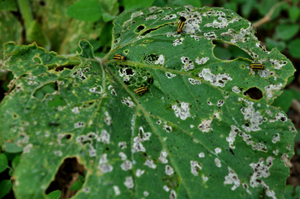 They attack flowers and ornamentals as well as cucumbers. In fact, over 270 plants in 29 families fall prey to this little trouble-maker.
They attack flowers and ornamentals as well as cucumbers. In fact, over 270 plants in 29 families fall prey to this little trouble-maker.
To learn more, I consulted Golden Harvest Organics online library. It was fascinating to learn (among other things) that the beetles actually transmit bacterial diseases which overwinter in their intestines, infecting plants in their earliest of stages.
According to ghorganics.com, the striped cucumber beetles do the most damage to the cucumber families or cucurbits, appearing a good four weeks before their spotted relatives.
Aside from hitting potatoes, squash, asparagus, tomatoes, fruits, and melons, they go after corn with a vengeance. Larvae infestation will impact the root system so forcefully, the corn appears to be drought-stricken. Adult beetles burrow into the silks when pollination is due to occur—resulting in “poor grain set.”
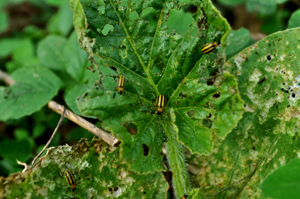 There are repellent plants which could be planted to deter the beetle and various other organic methods. (Try placing aluminum foil beneath plants to reflect light—the beetles prefer the underside of leaves because of the shade.)
There are repellent plants which could be planted to deter the beetle and various other organic methods. (Try placing aluminum foil beneath plants to reflect light—the beetles prefer the underside of leaves because of the shade.)
David prefers the route of “integrated pest management” (IPM). Which is our very next blog entry….
Stay tuned.

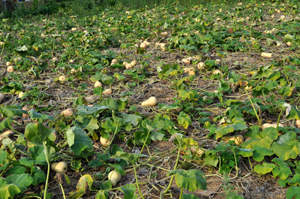 We grow rows and rows of butternut squash to allow proper garden space (after growing butternut for more than 10 years, I am still amazed at the amount of space the squash will eventually require).
We grow rows and rows of butternut squash to allow proper garden space (after growing butternut for more than 10 years, I am still amazed at the amount of space the squash will eventually require).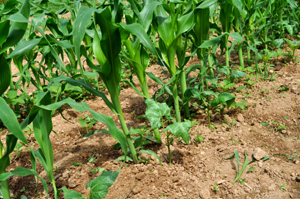 The beans are nestled close to the corn, and once trained, will likely be very happy to hitch a ride on the cornstalks. This saves us the trouble of arranging a trellis of some sort and is a connection to history we’re happy to make.
The beans are nestled close to the corn, and once trained, will likely be very happy to hitch a ride on the cornstalks. This saves us the trouble of arranging a trellis of some sort and is a connection to history we’re happy to make.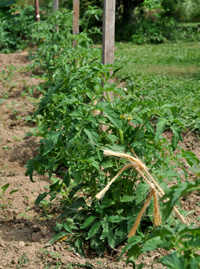
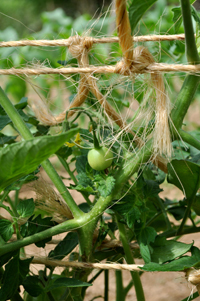 It all begins innocently enough: nothing beats the sweet smell of a little tomato plant on one of your first trips to the greenhouse in Spring (we just don’t bother to start tomato plants by seed—just a preference).
It all begins innocently enough: nothing beats the sweet smell of a little tomato plant on one of your first trips to the greenhouse in Spring (we just don’t bother to start tomato plants by seed—just a preference).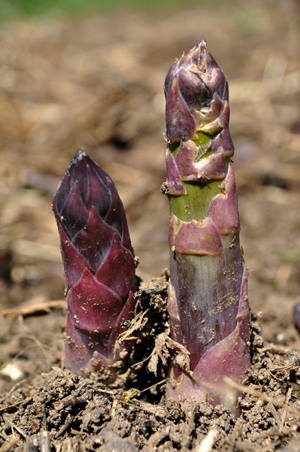 The day I visited Barb Dietrich at Oley Valley Organics a few weeks ago, it was still pretty chilly. That was probably a good thing because had I waited to schedule our little chat, chances are she’d be knee-high in asparagus weeding, harvesting, or both, right now!
The day I visited Barb Dietrich at Oley Valley Organics a few weeks ago, it was still pretty chilly. That was probably a good thing because had I waited to schedule our little chat, chances are she’d be knee-high in asparagus weeding, harvesting, or both, right now!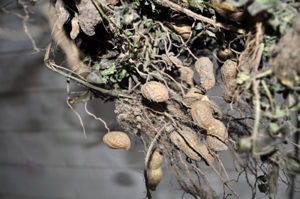
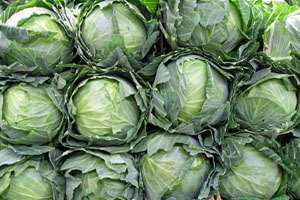 I believe sauerkraut was one of those accidental discoveries. Someone put cabbage in a vessel and just, plain, forgot about it. I’ve done that; who hasn’t? Typically, it’s something in the very back of the refrigerator though… resulting in a finale not quite as pleasant as sauerkraut.
I believe sauerkraut was one of those accidental discoveries. Someone put cabbage in a vessel and just, plain, forgot about it. I’ve done that; who hasn’t? Typically, it’s something in the very back of the refrigerator though… resulting in a finale not quite as pleasant as sauerkraut.
